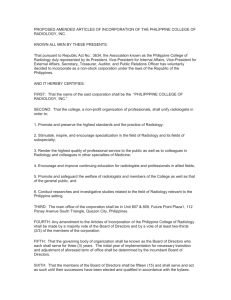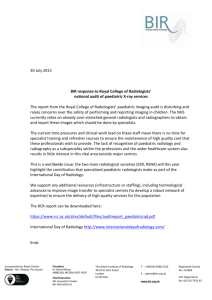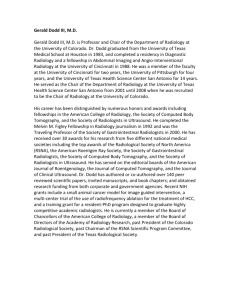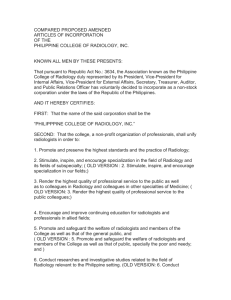Capital Retention in Radiology Practices
advertisement
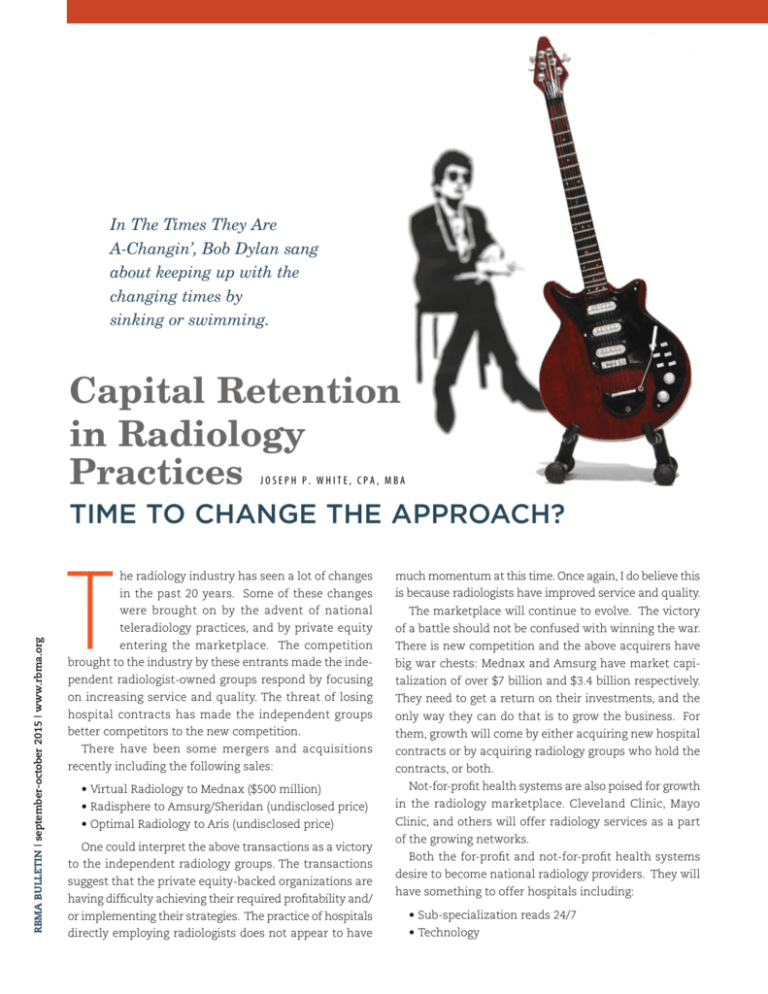
In The Times They Are A-Changin’, Bob Dylan sang about keeping up with the changing times by sinking or swimming. Capital Retention in Radiology Practices JOSEPH P. WHITE, CPA, MBA RBMA BULLETIN | september-october 2015 | www.rbma.org TIME TO CHANGE THE APPROACH? T he radiology industry has seen a lot of changes much momentum at this time. Once again, I do believe this in the past 20 years. Some of these changes is because radiologists have improved service and quality. were brought on by the advent of national The marketplace will continue to evolve. The victory teleradiology practices, and by private equity of a battle should not be confused with winning the war. entering the marketplace. The competition There is new competition and the above acquirers have brought to the industry by these entrants made the inde- big war chests: Mednax and Amsurg have market capi- pendent radiologist-owned groups respond by focusing talization of over $7 billion and $3.4 billion respectively. on increasing service and quality. The threat of losing They need to get a return on their investments, and the hospital contracts has made the independent groups only way they can do that is to grow the business. For better competitors to the new competition. them, growth will come by either acquiring new hospital There have been some mergers and acquisitions recently including the following sales: •Virtual Radiology to Mednax ($500 million) contracts or by acquiring radiology groups who hold the contracts, or both. Not-for-profit health systems are also poised for growth •Radisphere to Amsurg/Sheridan (undisclosed price) in the radiology marketplace. Cleveland Clinic, Mayo •Optimal Radiology to Aris (undisclosed price) Clinic, and others will offer radiology services as a part One could interpret the above transactions as a victory to the independent radiology groups. The transactions suggest that the private equity-backed organizations are having difficulty achieving their required profitability and/ of the growing networks. Both the for-profit and not-for-profit health systems desire to become national radiology providers. They will have something to offer hospitals including: or implementing their strategies. The practice of hospitals •Sub-specialization reads 24/7 directly employing radiologists does not appear to have •Technology •Gain sharing to keep the equation in balance. There are limits on the •Risk sharing on total cost of care contracts amount that a business can borrow, and thus a business •Big data needs to increase equity. This can come in two forms: •The reality (or perception) of higher quality capital contributed by investors or profits retained by the •The reality (or perception) of a higher level of service corporation. This is what I mean by owner financing. •Lower costs These factors and others lead me to believe that larger independent radiology groups are necessary in order to compete. I would envision that there will be large regional radiology groups, and eventually national groups. One of the characteristics/requirements of these groups is that they will have capital. Capital is absolutely required for growing a business. The Need for Capital A group practice administrator once told me, “It is easy The Benefits of Equity Why should a radiologist group retain capital? So that it is there when the group needs it. It is much harder to borrow money when you need it than when you do not, and it is very hard to raise equity when you need it the most. It is prudent to have reserves in the corporation as a “Rainy Day” fund. What happens if ICD-10 delays payments for months? Do you really want to borrow money to pay shareholder compensation? And what if a shareholder were to leave in the interim period? to retain profits in a medical group for 364 days a year; it is A business that has equity sees the world differently that last day that is difficult.” It is common for radiology than a business that doesn’t. It can afford to think more groups to bonus out all of the profits each year. There are strategically. It can dream of opportunities, both ones several reasons that this is done: that find them and ones they can search out. Should •The practice is organized as a C-Corporation and does not want to pay taxes on the retained profits. •The shareholders want their money. They earned it and they deserve it. •The value of the corporation does not change (or changes very little) if they leave profits in the corpo- the group consider purchasing other specialties? Should they purchase emergency physician practices or anesthesiology practices as Mednax has done? Could a group of radiologists have purchased Radisphere instead of Amsurg? Would it be possible for independent radiologists to create what is, in effect, their own private equity fund? Some specific examples of when capital is needed by medical groups: ration. •The banks would always lend the group 100 percent of any capital needed. •There was not a pressing need to leave the profits in. What would we do with the “reserves”? body has to get an equal distribution. The Definition of Capital Investopedia states: “’Capital’ can mean many things. Its specific definition depends on the context in which it is used. In general, it refers to financial resources available for use. Companies and societies with more capital are better off than those with less capital.” For the purpose of this article, capital—also called equity—refers to the owner-financed portion of the accounting equation shown below. Assets = Liabilities + Equity contracts from a system and needs to add 15 radiologists all at once. The sudden increase in payroll costs puts a severe strain on cash flow for nine months as the accounts receivable builds up and normalizes. It cannot afford to consider other opportunities during this time frame. •A medical group wants to buy itself out of a management service agreement with a private equity fund. In order for the group to have consensus, they feel that they need to assure the shareholders: They will not take a cut in pay over the They will not have to guarantee any bank debt They will not have to work more They will not have to put in of their own previous year money. The group doesn’t have any equity and the bank As this fundamental equation shows, as the asset side will not lend them the funds because the physicians of the equation grows either the liabilities or the equity are not putting any money into the deal as some (or a combination of the two) needs to increase in order of the younger physicians does not have the funds. RBMA BULLETIN | september-october 2015 | www.rbma.org •One of the shareholders needs the money so every- •A radiology group is awarded three new hospital CAPITAL RETENTION IN RADIOLOGY PRACTICES – TIME TO CHANGE THE APPROACH? The physicians has been making 40 percent more in 2012 than 2014…2012 was the time to plan ahead and build up some reserves. •A radiology group has the opportunity to purchase a nearby competitor’s imaging center for $3 million. The center shows a loss of $300,000 per year but the deal includes the real estate for the imaging center. The group will purchase the center and then immediately close it down, so the volume/patients will be transferred to the existing center. This will add $2 million in profits to the existing imaging center. The bank was only willing to lend them $2 million, so the group needs to raise $1 million internally. Of course a few of the radiologists does not have the ability to raise the funds personally. This creates a fair amount of concern and commotion in the group. A Possible Option for Large Groups or Networks Private equity groups, including Radiology Partners, service metrics •Fear of losing hospital contract to the national forprofits or not-for-profits If an independent group came in with a bit of capital, it would allow the transaction to get done quickly and efficiently. They could use some capital to buy out some of the partners near retiring shareholders, or pay them to retire early. The purchaser would get a return on its investment in the same way other acquirers would—by absorbing the work—and by having better contracting and through cost savings on overhead expenses. Mergers between radiology groups are time intensive and expensive, from both a legal and accounting perspective, and a little bit of capital would go a long way! Would it make sense for organizations like Strategic Radiology or Preferred Radiology to acquire groups that are looking for help? The Hurdles to Equity Build Up There are several hurdles to overcome when considering Aris, and Imaging Advantage, have been searching for building equity in a radiology practice but two of them are and acquiring radiology groups as a way to get hospital income taxes and buy-in and buy-out arrangements. contracts. Many times they will offer a lump sum cash payment to the group in return for some of the group’s future cash flow. In order for the group to have this cash flow, the radiologists agree to take a lesser amount of future compensation. This may work for the 65-yearold radiologist who wants to practice for only two more years, but the 45-year-old does not see the benefits. It is the 45-year-old physician’s viewpoint that has made acquisitions difficult for private equity in metropolitan marketplaces. RBMA BULLETIN | september-october 2015 | www.rbma.org •Group being unable to substantiate quality and Another strategy is to acquire groups that have shareholders who are going to retire in the near term. The acquirer does not replace the retiring shareholders, and the work is shifted to other radiologists either through teleradiology or by requiring more productivity from the remaining radiologists. Could independent radiology groups get into this game? Would some of the groups contemplating selling consider selling to a larger radiology group rather than private equity? I would think they would prefer it. The “selling” group could feel the need to be acquired for a variety of reasons: •Hospital requiring sub-specialization 24/7 •Senior physicians approaching retirement and difficulty in recruiting quality physicians •Inability of the group to govern itself •Inability of the group to find quality management INCOME TAXES Arthur Godfrey said, “I am proud to be paying taxes in the United States. The only thing is—I could be just as proud for half the money.” Eventually equity has to be paid for with after-tax dollars. It is painful, but true, so the goal is do it in the most efficient way possible. The options for how to do this depend upon the structure of the entity: C-Corp; S-Corp; or LLC/LLP. C-CORPS C-Corps are the most tax-inefficient way of doing business. The profits retained are subject to income taxes, and the shareholders are additionally taxed upon sale of their stock or when receiving any dividends. Some groups do decide to bite the bullet and pay the tax. It is simple and if a fixed amount of profit (in total or per shareholder) is left in every year, even a small amount will add up over the years. Another option is to pay out a bonus each year and require the shareholders to lend a certain (say $10,000) amount back to the corporation. The corporation should do a formal note paying interest at 10 percent. When the radiologist retires, the note is then repaid over five years. This is a great way to build equity from shareholders and rewards those who leave the money in the company. S-CORPS AND LLCS/LLPS CliftonLarsonAllen, LLP, is a professional partnership that I am a partner in. Each year we distribute 100 CAPITAL RETENTION IN RADIOLOGY PRACTICES – TIME TO CHANGE THE APPROACH? percent of the profits and then each partner is required to contribute back a calculated share of the projected addi- Conclusion The sponsored ad of Morgan Stanley on the front page tional capital needs. The calculation is based upon income of the Wall Street Journal on July 15 says “Capital Creates and years of service, and the partnership pays a 10 percent Change—we work with visionary companies to bring big return on the contributed capital. It is done with after tax ideas to life—harnessing capital, not just to create wealth, dollars so it is painful, but worth it. We are not beholden but also to create positive change.” to a bank, and we have capital to fund growth. Radiology groups that are S-Corps and LLCs/LLPs can operate in a similar manner with similar success. Buy-in/Buy-out Arrangements There must be an incentive for radiologists agreeing to let profits stay in the practice. This should come in the form of a return on the investment, plus the chance for some stock appreciation. Most radiology groups do not put much of a value on the practice itself in the buy-in or buy-out arrangement. While I understand why it is done that way, Most managers of radiology groups would agree that capital retention is something that should be done, but feel that getting group consensus to do it would be next to impossible. However, if groups do not start to do it, right now, they may end up with the same fate as most independent primary care groups: sold to a system, or as Dylan puts it, “sink like a stone.” Radiology groups that have equity will have the two critical elements needed for success: an engaged radiologist workforce with emotional (and real) ownership and the capital to grow. the concern is that it may not reflect fair market value thus creating a dilemma if the group ever contemplates selling, as no one wants to sell for less than fair market value. Using a method that tries to reflect fair market value creates an incentive to increase the value. The shareholder will see the benefit of leaving profits in the corporation and invested when it results in a higher buy-out amount. As independent groups become regional and national in scope, I believe they have a greater value. Doesn’t a group with per-radiologist income that is 150 percent higher RBMA BULLETIN | september-october 2015 | www.rbma.org than another group seem like it has more inherent value? JOSEPH P. WHITE, CPA, MBA, healthcare principal at CliftonLarsonAllen, specializes in serving physician groups and healthcare systems. He has over 30 years of experience in consulting, tax, and assurance services in the healthcare field. He is also on faculty at the University of St. Thomas teaching in The Center for Health and Medical Affairs, the Physician Leadership College, and The Executive MBA Program. Joe can be reached at (612) 376-4525 or joseph.white@CLAconnect.com.

